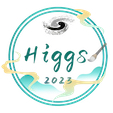Conveners
Parallel: Di-Higgs: 1
- Arely Cortes Gonzalez (Humboldt-Universität zu Berlin)
- Shankha Banerjee (IMSc, Chennai)
Parallel: Di-Higgs: 2
- Jonathon Langford ()
- Christina Gao (University of Illinois Urbana Champaign)
- Davide Zuliani ()
We consider the next-to-leading order electroweak corrections to the Higgs boson pair and Higgs plus jet productions in gluon fusion. This requires the computation of two-loop four-point amplitudes with massive internal particles such as top quarks, Higgs and gauge bosons. We perform analytic calculations both in the high-energy and large top-quark mass limits. In particular, we show that our...
We calculate the next-to-leading order electroweak corrections proportional to the Higgs trilinear self-coupling for Higgs boson pair production in gluon fusion.
In the Standard Model, the ground state of the Higgs field is not found at zero but instead corresponds to one of the degenerate solutions minimising the Higgs potential. In turn, this spontaneous electroweak symmetry breaking provides a mechanism for the mass generation of nearly all fundamental particles. While the Standard Model makes a definite prediction for the Higgs boson self-coupling...
Recent results on studies of Higgs boson pair (HH) production are presented, exploiting data collected in Run 2 of the LHC by the CMS experiment. A variety of Higgs boson decay channels will be studied, ranging from those with large branching fractions (combinations of H->bb and H->VV) to thos with smaller branching fractions. Limits are presented on nonresonant HH production via gluon-gluon...
The discovery of the Higgs boson in 2012 was a triumph for the Standard Model (SM) of particle physics and the mechanism of electroweak symmetry breaking. An essential ingredient to this mechanism is the Higgs potential, which is introduced ad-hoc and assumed to be Mexican-hat shaped in the SM, but cannot be derived from first principles. It is therefore important to probe this shape...
QCD corrections to Higgs Boson pair production are known at N3LO in the Heavy Top Limit and NLO including the top quark mass. However, the complete NLO electroweak corrections are currently missing. Given the current focus of the LHC experiments and knowing that the electroweak corrections to single Higgs production amount to around 5% and vary strongly depending on the mass of the Higgs...
We calculate the total cross-section and differential distributions of Higgs boson pair production and decay to $b\bar{b}\gamma\gamma$ at NLO in QCD.
We present the latest results on resonant searches for di-Higgs production from the CMS experiment. The results are presented as upper limits on the production of a heavy resonance that decays to two 125 GeV Higgs bosons. We will also cover searches for a heavy resonance decaying to a 125 GeV Higgs boson and another heavy resonance.
A search for di-Higgs boson production in the bbγγ final state is presented, using data collected by the ATLAS experiment during the second data-taking period (Run 2) of the LHC, amounting to an integrated luminosity of 140/fb. Searching for Higgs boson pairs provides an excellent handle for understanding the fundamentals of the Higgs mechanism, and in particular for measuring the trilinear...
Several physics scenarios beyond the Standard Model predict the existence of new particles that can subsequently decay into a pair of bosons. These include pairs of SM-like Higgs bosons (HH) as well as asymmetric decays into two scalars of different masses (SH). This talk summarises ATLAS searches for resonant HH and SH production with LHC Run 2 data. A search for a high-mass Zgamma resonance...

